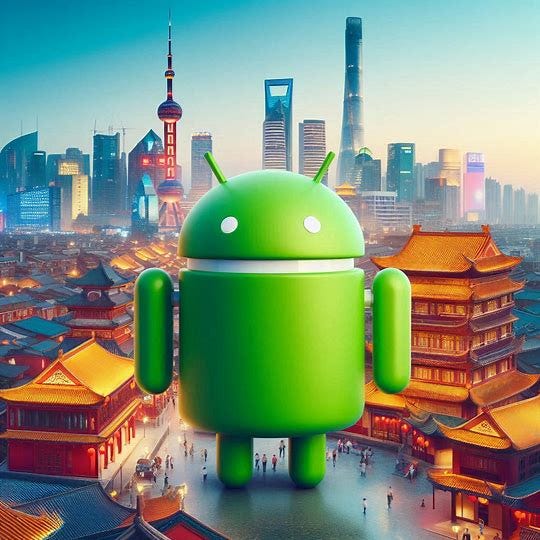China's open source AI push an "Android moment"
Plus: Pebble returns and figuring out the value of open source.
In issue #9 of Forkable, we look at China’s efforts to play catch up in the AI race by going all-in on open source.
Plus, just a few short months after Google open sourced the Pebble smartwatch software, a duo of new watches have gone on pre-order from one of the Pebble’s original creators.
Paul
Open issue
China play catch-up using open source AI
DeepSeek reignited the open vs. closed AI debate in a big way this year, after the Chinese hedge fund-owned AI developer released a powerful new reasoning model with a cost-to-performance ratio that sent Wall Street into meltdown and forced everyone in the AI space to sit up and take note.
Mark Andreessen, meanwhile, recently called DeepSeek’s R1 reasoning model “AI’s Sputnik moment” in reference to the Soviet Union’s 1957 satellite launch which spurred the subsequent “space race” and led the U.S. to invest heavily in a domestic space program.
However, it’s not just DeepSeek banging the open source AI drum in China. Baichuan has raised bucketloads of cash from the likes of Alibaba, Tencent, and Xiaomi to build open source AI models — including a recently announced multimodal large language model (MLLM) that can handle multiple data modalities simultaneously. And Tencent itself just this week unveiled five open source AI models for converting text and images into 3D visuals.
So while the U.S. is hell-bent on imposing blocks on domestic tech companies shipping AI tech to China (as well as banning Chinese AI tech on U.S. government devices), it seems that China is going the opposite way (out of necessity!) by embracing open source AI to make gains on proprietary incumbents such as OpenAI, which went so far as to block access to its services in China last year.
In an interview with CNBC this week, Tim Wang, founding partner at Hong Kong-based hedge fund Monolith Management, likened what’s going on in China to two well-known open source projects — Android and Linux.
“I think open source models like DeepSeek or Baichuan are great enablers and multipliers in China,” Wang said. “I think it's an Android or Linux moment, as all these open source models are free, anybody can deploy it. And the inference cost of that is a fraction of buying APIs from the closed source models. That puts a lot of the companies on a level-ground in China, and it opens a lot of doors for product innovation. [It also] demonstrates how things can be done with very limited resources. I would say that used to think China is 12-to-24 months behind in AI, and now we think it's probably three to six months.”
Android isn’t the only Google-led project that has been compared to China’s open source AI efforts, though. Earlier this year, Yishan Wong, ex-CEO of Reddit and a former engineer at PayPal and Facebook, countered Andreessen’s Sputnik analogy when he compared DeepSeek’s R1 launch to something Google did nearly two decades ago. Google published a duo of papers that served as a blueprint of how it built an in-house distributed system to generate “substantial computing resources at low cost.”
Basically, it helped lay the foundations for many of the principles that drive cloud infrastructure today.
So whether China’s open source AI push is a Sputnik moment, a Google moment, an Android or Linux moment, or something else, it’s definitely a moment — a “moment” that means open source AI wins in the long-run.
The rundown
The return of Pebble
Back in January, Forkable reported that Google had open sourced the original software for Pebble, the smartwatch that smashed all manner of crowdfunding records before Fitbit acquired it in a 2016 firesale. Google went on to acquire Fitbit, alongside Pebble’s assets.
When Google revealed it was giving the software over to the community, Pebble’s original founder and CEO Eric Migicovsky revealed that he wanted to have another go at a Pebble-like product. Migicovsky hasn’t wasted any time, either, as this week he announced a new company called Core Devices which is bringing to market two new smartwatches that pack the PebbleOS software.
The Core 2 Duo, sporting a black-and-white display and polycarbonate frame, costs $149 and will start shipping July. The Core Time 2, with a larger colour display and metal frame, will set you back $225 and will ship in December.
Both are available for pre-order now.
The value of open source
I was inundated with pitches this week that referenced data points from a Harvard study that delved into the value of open source software. These pitches followed after Hugging Face co-founder and CEO Clément Delangue tweeted a link to the report, which concluded that for every $4.2 billion invested in open source software, $8.8 trillion of value is created for companies — so that’s around $2000 of value for every $1 spent.
“I suspect that these numbers and impact are even greater for AI than for software,” Delangue wrote.
While some of the data points are interesting, the report is in fact well over a year old, and I recognize quite a few of the data points from attending various open source events over the past year.
If nothing else, though, this shows the value for the researchers in having influential people with many followers tweeting out links to your study. And in truth, it’s no bad thing to be reminded of the value of open source, vis-à-vis companies apparently would need to spend more than three times the amount they currently spend on software if open source software didn’t exist. (Though Sentry’s head of open source Chad Whitacre has previously called foul on some of the conclusions in the study).
Understanding ATProto
I stumbled upon what I thought was a very useful read on ATProto, the open source, open standards-based protocol that underpins X (née Twitter) rival Bluesky.
ATProto Isn't What You Think, published by a social web collective called Muni Town, dives into the fabric of both ATProto and Bluesky, addressing criticisms of its decentralization (or not…) while highlighting some of the pros of how Bluesky treats data differently to fully centralized apps such as X or Discord.
Anyway… it’s a good read if you want to understand Bluesky and ATProto a little more from a technical perspective.
Patch notes
Google released an updated version of its OSV vulnerability scanner, packing new features including integration with Google’s recently open sourced software composition analysis library OSV-SCALIBR.
GIMP, the open source image manipulation program, got its first major upgrade in seven years this week with version 3.0 released to the masses.
Swedish developer tooling company ReRun this week announced a $17 million seed round of funding for its open source development platform for “physical AI” (e.g. robotics and drones).
Speaking at Nvidia’s GTC conference this week, Mistral AI CEO Arthur Mensch quashed rumours that the French startup is planning an IPO, insisting that the company is refocusing its efforts on open source AI to counter the rise of DeepSeek in China.





